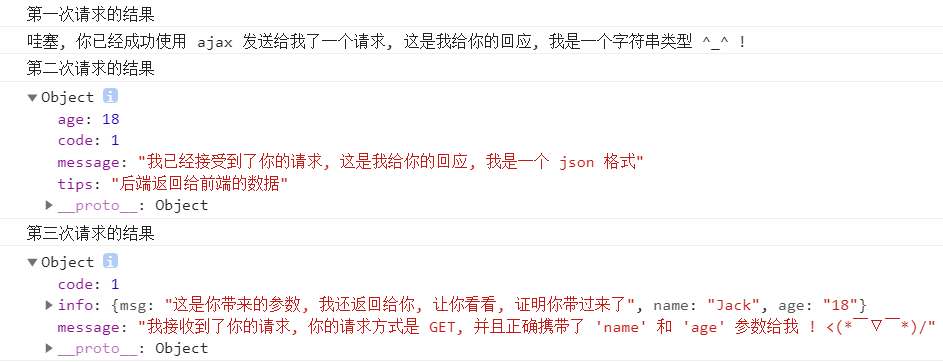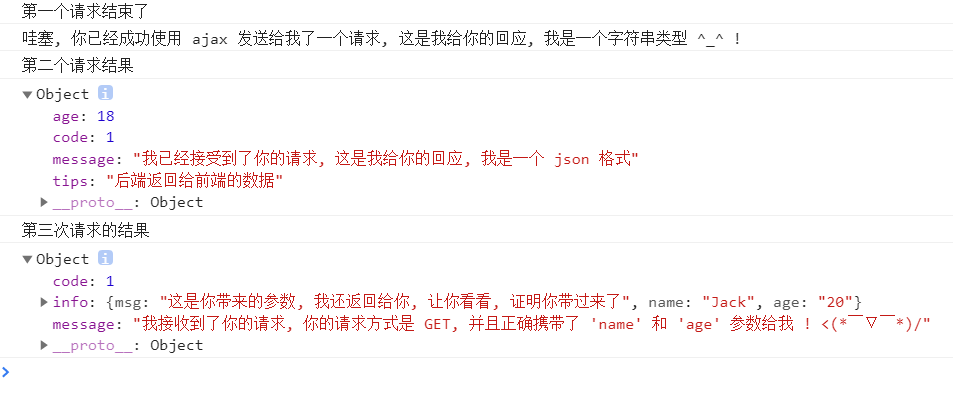1. callback function
-
A means of encapsulating code
-
What is the concept of callback
=>Pass function A as an argument to function B
=>Call function A as A formal parameter inside function B
=>We call this behavior a callback function
=>We say that function A is the callback function of function B
function A() {
console.log('I am A function')
}
function B(fn) {
// At this time, fn parameter accepts the content inside () when written in B(): A
// At this time, fn parameter accepts the address of global function A
// At this time, fn parameter and global variable A operate on A function space
console.log('I am B function')
// Calling fn is actually calling and executing the global A function
fn()
}
// Call B function
// A is the address of a save function
// The address of function A is passed as an argument to the fn parameter inside function B
B(A)
// Function A is the callback function of function B
-
Why do I need a callback function
-
If the code is synchronized from beginning to end, no callback function is required
=>When you're encapsulating code
=>And there are asynchronous times in the code
=>And you need to do something at the end of asynchrony
=>Using callback
Explanation: why do asynchronous end encapsulation use callback
-
Because JS is a single thread, you can only do one thing at a time
-
Main: the end time of asynchrony is uncertain
-
Example: takeout
=>A takeout can only do one thing at a time
=>If you want to bring an extra pair of chopsticks
=>Scheme 1: call the takeout when he just arrives at the store
=>Option 2: give a note when ordering
-
Callback hell
-
When callbacks are nested callbacks, the code reading and maintainability are not high
Solve the problem of callback Hell:
-
Promise to solve the callback hell
-
analysis:
=>Promise is to solve the callback hell
=>Callback hell is because callback functions are nested too much
=>Callback function, in order to solve the encapsulation of doing something at the end of asynchrony
=>Promise is an elegant scheme for asynchronous code encapsulation
// Why do I need a callback function
// Encapsulate a piece of code
// Example: what the takeout company does well
function waimai(beizhu) {
// Get a random integer from 1000 to 6000
const time = 1000 * Math.round(Math.random() * 5 + 1)
console.log(' on the way ' + time)
// We use setTimeout to simulate a network environment request
setTimeout(() => {
console.log('Arrived at the store, Get the takeout')
// Put the code I need to execute directly in this position
// Then this encapsulation is meaningless
// You need to use the callback function
// Because this position is the end of asynchrony
// Calling beizhu from this location is called at the end of asynchrony
// No matter when you arrive at the store
// After you get the takeout, carry out the notes
beizhu()
}, time)
}
// User needs: want to take an extra pair of chopsticks
waimai(function () { console.log('Take an extra pair of chopsticks') })
// User needs: want to get more pepper
waimai(function () { console.log('Get more pepper') })

2. Callback hell
understand
-
A situation when using callback function to encapsulate code
-
Callback functions are nested inside
-
When you use a lot of code encapsulated by callback functions, there will be structural disorder
=>It is not conducive to code reading and maintenance
-
To solve the callback hell
=>A new syntax called Promise appears in the syntax of ES6
=>To turn asynchronous code encapsulation into Promise syntax encapsulation
=>Callbacks are no longer used to encapsulate asynchronous code
=>Essence: used to encapsulate asynchronous code
Implementation requirements:
-
Send a request, request an interface
=>Wait until the response comes back
=>Print content on console
-
Send the second request and request the second interface
=>The request must be sent again after the first request and after printing
=>Print the response on the console
-
Send the third request and request the third interface
=>It is required to send the request again after the second request and after printing
=>Print the response on the console
<script src="jquery.min.js"></script>
// Realize requirement 1:
$.ajax({
url: 'http://localhost:8888/test/first',
success: function (res) {
console.log('Results of the first request')
console.log(res)
// When the code in this position is executed, it must be the end of the first request
// Demand 2:
$.ajax({
url: 'http://localhost:8888/test/second',
dataType: 'json',
success: function (res) {
console.log('Result of the second request')
console.log(res)
// When the code in this position is executed, it must be the end of the second request
// Demand 3:
$.ajax({
url: 'http://localhost:8888/test/third',
data: 'name=Jack&age=18',
dataType: 'json',
success: function (res) {
console.log('Results of the third request')
console.log(res)
}
})
}
})
}
})
ajax here uses jquery

3. Know Promise
-
Is a syntax that appears in ES6
-
Promise is also a JS built-in constructor
-
promise - commitment:
- How many committed states are there?
=>Continue (during continuous execution)
=>Success
=>Fail - Conversion between commitment states: can only be converted once
=>Or continue to convert to success
=>Or continue to convert to failure
- How many committed states are there?
-
Promise also has three states
=>Continue: pending
=>Success: fulfilled
=>Failed: rejected
const p = new Promise(function (resolve, reject) {
// ...
// ...
})
// Register a successful function for the current commitment
p.then(function () {
})
// Register a failed function for the current commitment
p.catch(function () {
})
How to change promise status
- In the a function of new Promise
- Two parameters are acceptable
1. The first parameter: you can convert the Promise status from continue to success
2. Second parameter: the Promise status can be changed from continue to fail
// 1. Asynchronous code
const p = new Promise(function (resolve, reject) {
// resolve is a successful conversion method
// When you write resolve(), you are converting the promise state to success
// Will execute the b function written in. then
// reject is a method of converting to failure
// When you write reject(), you are converting the state of the promise to failure
// It will execute the c function written in. catch
// These two can only write one
// Write asynchronous code that you need to encapsulate
const time = 1000 * Math.round(Math.random() * 5 + 1)
console.log('Promise to be together all your life')
setTimeout(() => {
if (time >= 3000) {
// resolve() calls the function b inside then
// So the time content written inside () here is the argument to b in then
resolve(time)
}
else {
// reject() calls the catch internal function c
// Therefore, the time content written in () here is the argument to c in catch, and it is also an error message
reject(time)
}
}, time)
})
// Two methods called by promise object
// Registration succeeded
p.then(function b(t) {
// Function b will not be called directly
// The code in this position will be called and executed when p the promise state changes from continue to success
console.log(t, 'Successful function b')
// t is the content of time in the resolve parentheses written inside promise
})
// Registration failed
p.catch(function c(err) {
// Function c is not called directly
// The code in this position will be called and executed when p the promise state changes from continue to fail
console.log(err, 'Failed function c')
})

4. Advanced syntax of promise
-
When a Promise is then within the code
-
As long as you return a new promise object inside the previous then with return
-
Then of the new promise object can continue writing then directly after the previous then
Requirements:
-
Send a request for the first interface
-
Send the second request and request the second interface
=>Premise: you must wait until the end of the first request to send it again
function myPromiseAjax(options = {}) {
const p = new Promise((resolve, reject) => {
// Execute ajax
$.ajax({
url: options.url,
data: options.data,
type:options.type,
dataType: options.dataType,
success: function (res) {
resolve(res)
}
})
})
// Return my promise object
return p
}
myPromiseAjax({
url: 'http://localhost:8888/test/first'
})
.then(res => {
console.log('The first request is over')
console.log(res)
// return a new promise object
return myPromiseAjax({
url: 'http://localhost:8888/test/second',
dataType: 'json'
})
})
.then(res => {
console.log('Second request result')
console.log(res)
// return a new promise object
return myPromiseAjax({
url: 'http://localhost:8888/test/third',
data: 'name=Jack&age=20',
dataType: 'json'
})
})
.then(res => {
console.log('Results of the third request')
console.log(res)
})

5. async function and await keyword
-
Syntax between ES7 and es8
-
effect:
-
In order to solve the Promise problem, write the Promise code more gracefully
-
Core function: write asynchronous code to look like synchronous code, but the essence is asynchronous
Syntax:
=>Async keyword (asynchronous)
- Use: write in front of the function
(it can be a declarative function, a function expression, or an arrow function)
// async syntax
async function fn() {}
const fn = async function () {}
const fn = async a => {}
effect:
-
The await keyword can be used in this function
-
It will turn this function into an asynchronous function, just called an asynchronous function
(this asynchronous function is not our real asynchronous code, but gives this function a name)
=>It affects the code inside the function and does not affect the code outside the function
await keyword (wait)
- requirement:
-
await must be written inside an asynchronous function with async keyword
-
What await waits for must be a promise object, otherwise it can't wait
-
effect:
=>The results in promise that should have been accepted by the code in then,
Variable acceptance can be defined directly in front of await
=>Subsequent code will not be executed until promise is executed
console.log('start') // ① start
async function fn() {
console.log('I am fn Code inside the function') // ②
// Because pAjax is code encapsulated according to the syntax form of promise
// pAjax returns a promise object
// fn function, when the code of pAjax is executed
// Will wait until the asynchronous code is completely executed and the result is assigned to r1
// Continue to execute the following code
const r1 = await pAjax({ url: 'http://localhost:8888/test/first' })
console.log(r1) // ④
}
fn()
console.log('end') // ③ end

console.log('start')
async function fn() {
console.log('I am fn Code inside the function')
// At this point, the await keyword can be used in the fn function
// The promise object returned by pAjax will execute
// Assign the contents in parentheses to r1 during resolve(). Continue to execute the code backward
const r1 = await myPromiseAjax({ url: 'http://localhost:8888/test/first' })
console.log(r1)
// //Demand 2:
const r2 = await myPromiseAjax({
url: 'http://localhost:8888/test/second',
dataType: 'json'
})
console.log(r2)
// Demand 3:
const r3 = await myPromiseAjax({
url: 'http://localhost:8888/test/third',
data: 'name=Jack&age=20',
dataType: 'json'
})
console.log(r3)
}
fn()
console.log('end')
